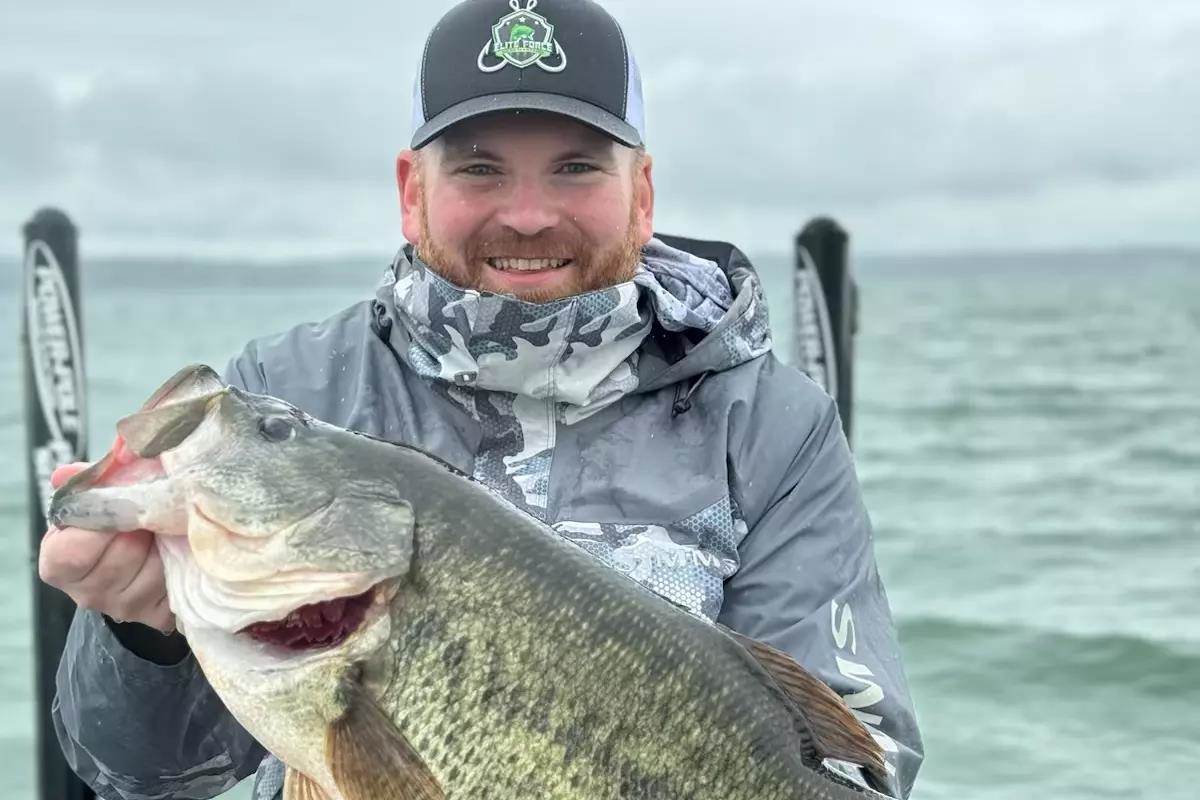
With all due respect to Lake Erie to the west and the St. Lawrence River to the north, the waters of Cayuga Lake, located in the heart of the famed Finger Lakes region in central New York have become the epicenter of bass fishing in the Empire State.
The latest highlight occurred in the early afternoon on July 11 when Jim Britenbaugh landed the state record largemouth, continuing an unprecedented trend at a lake previously best known for its proximity to a bevy of wineries and scenic waterfalls. Britenbaugh, a resident of Fairfield, Pa., was practicing for a tournament when he landed a 12.35-pound fish, topping the previous record by more than a pound.
“It is so cool,” Britenbaugh said in a phone interview Friday evening. “I never thought I’d see myself in a position like this. Heck, I never thought I’d see a fish like that.”
Indeed, by any measure in any state, a 12-pound largemouth is a behemoth of a fish, especially for a northern strain largemouth, but Cayuga has recently developed a knack recently for producing headline-grabbing bass.
While the state hasn’t made an official announcement yet, Britenbaugh said he was informed by officials from the New York State Department of Environmental Conservation on July 12 that his catch will be certified as the record, giving Cayuga the distinction of being the source of the state’s biggest smallmouth bass and largemouth bass, both caught within the last 25 months. Thomas Russell Jr. set the smallmouth record with an 8-pound, 6-ounce catch in June 2022.
The previous New York largemouth record was held by John Higbie, who caught an 11-pound, 4-ounce fish using a spinnerbait at Buck Horn Lake in September 1987.
Britenbaugh, a 38-year-old facilities manager for an industrial refrigeration manufacturer, was at Cayuga preparing for a Pennsylvania Bass Federation Team Regional tournament that was scheduled for July 12-13. On July 10, he made the 5-hour drive from his home just west of Gettysburg, Pa., to Union Springs, N.Y., on the eastern shore of Cayuga with plans to start his pre-fishing routine for the tournament. He wasn’t able to get on the water, though, as remnants of Hurricane Beryl were still pushing through the area. That left the following day as his only day of on-the-water preparation with a 3 p.m. deadline to be off the water.

Britenbaugh, a married father of two, is a member of the Elite Force Bassmasters based in southeastern Pennsylvania. He’d fished Cayuga a half dozen times before in different tournaments prior to his most recent visit. Once he got on the water for practice, he wanted to explore areas where bass were holding in and around grass, both deep and shallow.
“I didn’t want to lean on any area too much,” he said. “I wanted to catch a few from each area to understand the class of fish that was there. I wanted to catch a few but didn’t want to hurt anything that I’d want to come back to in the tournament.”
He began the day solo in the boat because Dave Ruark, his practice partner, had work obligations that delayed his arrival until 11 a.m. After picking up Ruark at the dock at Frontenac Park in Union Springs, they headed south to check some water in the mid-lake area. It was an area Britenbaugh remembered being in the spotlight in 2014 when Greg Hackney combed deeper grass when he won the first Bassmaster Elite Series event held at Cayuga.
“I figured if the deep grass is there, it has the potential to hold big fish,” he said.
Sure enough, the deeper grass in 18 to 20 feet of water was there, but the bass didn’t seem to be along or just inside the outer edge. As they approached a main lake point, the grass line seemed to swing in tighter to the bank, Britenbaugh said. He panned around with live sonar to better understand how the vegetation layed out in relation to the point.
“It seemed to be a perfect storm where there was an intersection of the grass line, the point and access to deeper water,” he said.
They poked around in 16 to 18 feet of water and worked their way in to about 10 feet where there was a mix of what appeared to be coontail and hydrilla. He caught a 6-pounder to give him a sense he’d found a good stretch. He had to temper his enthusiasm, though, as another competitor was idling through the area and stopped to ask about the catch. Britenbaugh and Ruark downplayed it in hopes their counterparts would continue on.
About five casts later, he opted to pick up a spinning combo equipped with a wacky-rigged soft plastic stickbait and fired it into the grass. As he worked it nearly back to the boat, he felt something.
“I was about to lift it out of the water and I felt a hit,” he said. “It wasn’t anything crazy. Just a solid hit and I could tell my line was moving. I reeled up the slack and set the hook and the rod didn’t move. It doubled over.”
Initially, he thought it may have been a snag, but then he felt the fish pulling as he applied pressure. Ruark asked what he thought it was. He told him he didn’t believe it was a bass.
“Whatever it is, it’s huge,” he told him. “I told him to keep fishing and if I needed the net, I’d let him know.”
He said the fish darted under the boat and back into the grass, but then slowed and made another runaway from the boat. He finessed his line under and around the trolling motor and the fish finally revealed itself.
“I could see it coming to the surface and that’s when I realized it was a bass,” he said. “Across its back, I hadn’t realized how big it was.”
Ruark saw it, too, and hurried for the net while surmising it was a 7-pounder. Moments later, the fish turned to the side and the men saw how wide it was.
“That totally changed the atmosphere in the boat from ‘That’s a good one,’ to ‘Oh my God, what is this,’” he said.
The fish jumped briefly and tail-walked across the surface roughly 15 feet from the bow. he was able to gain more control at that point and Ruark scooped it with the net on his first try.
“The thing about Dave is he’s a hammer,” he said. “He’s good with a rod and reel, but he’s also good with a net.”
Once the net and fish were safely in the boat, it took a few moments for the men to compose themselves.
“We didn’t know what to say to each other,” he recalled. “We were flabbergasted and we both said some things to each other, but it was pure gibberish. It was like we were speaking in tongues.”
Ruark, who frequently fishes the Chesapeake Bay in Maryland and has caught his share of 5-, 6- and 7-pound bass, told Britenbaugh he’d never seen a bass of this caliber before. As the men were trying to gauge the size of the fish and what to do next, they realized the other competitor’s boat was still about 50 yards away. Not wanting to draw too much attention to the spot, they discreetly placed the fish in the livewell and tried to contain their excitement.
A few minutes later, they weighed the fish on his digital scale and it immediately read 12.08 pounds. Ruark quickly looked up the previous state record online and when they discovered it was a potential historic catch, “we knew we had a different situation on our hands,” Britenbaugh said.
Ruark then weighed the fish on his digital scale. It read 12.25 pounds.
“It was pure bedlam in the boat at that point,” he said, whose previous best largemouth was a 7-pound, 1-ouncer caught years ago at a private pond in southwestern Pennsylvania.
They began making their way back to Frontenac Park and called the DEC to request a field officer meet them at the boat ramp with a certified scale to confirm the weight of the fish. They were told it would be about 45 minutes to an hour before someone could be there. It seemed like an eternity for Britenbaugh and Ruark, the latter of whom kept fishing in order to maximize his practice time. Britenbaugh, meanwhile, called some friends to alert them about his catch while lifting the lid of his livewell to check on the fish “just about every minute.”
“I was in absolute disbelief,” he said. “I’d never seen anything like it in my life. I never imagined myself being the guy something like this would happen to.”
When they arrived back at the ramp around 2 p.m., not only were there two DEC staffers waiting for them, but also a crowd of fellow anglers who wanted a glimpse at the fish. While the scales were set up on the tailgate of a pickup truck at the top of the ramp, he placed the fish in a weigh-in bag and hauled it to shore.

Video posted to social media shows the fish first being placed on two separate scales – a digital metric scale that read 5.603 kilograms, which converts to 12.35 pounds, and one imperial dial scale where the needle surged past 12-pound mark. Its length was then taken, and the audio indicated the fish to be 634 (millimeters), which translates to just shy of 25 inches. The girth wasn’t recorded by the DEC, but Britenbaugh said he used a length of fishing line to determine it was 21 inches.
He said the DEC officials told him the same scales were used to measure and certify Russell’s record smallmouth two years ago. The DEC harvested scales from Britenbaugh’s fish to determine its age and based on their brief examination of the fish they concluded the fish had already spawned.
As memorable and exasperating as the catch and aftermath both were, he said releasing the fish back into the lake was “pretty somber”. Another member of his club accompanied him back to the area where it was caught and after taking additional photos and video, it was released over deep water and swam away.
“It was a surreal feeling,” he said. “When I put it over the side (of the boat), I didn’t want to let it go but at the same time you want to let it go and let it live as long as possible.”
If it’s ever caught again, Britenbaugh said it’ll be easy to determine if it’s the same fish he caught.
“On its left lower gill plate, it had a small black spot,” he said. “We thought it was funny because everybody always talks about Dottie, the famous bass from California that supposedly weighed 25 pounds and had a distinct mark on her. We were joking about calling this fish ‘Spotty’. That will be vivid in my mind until the day I die.”
The rest of the afternoon and evening were a blur, he said. He and some of his fellow tournament competitors went to dinner at a local pizzeria that night and after stepping outside to take a phone call, Britenbaugh looked up to find several people, total strangers who’d heard about his catch, wanting to congratulate him and hear about it.
“It’s just been overwhelming—the support I’ve gotten from friends, family and strangers,” he said.
Britenbaugh got to celebrate the catch again Friday morning during day 1 of the tournament when a DEC official called him to inform him their scales were determined to be off by less than a gram and that his catch would be certified at 12.35 pounds (roughly 12 pounds 5 ½ ounces). He said he plans to have a replica made.
“I’m just a normal guy like everybody else and I have my struggles like other people, but the catch of that fish … it was just on time,” he said. “I couldn’t have planned it any better.”






![Air gun 101: The differences between .177 & .22 – Which jobs they do best ? [Infographic]](https://airgunmaniac.com/wp-content/uploads/2020/09/g44-218x150.jpg)



































